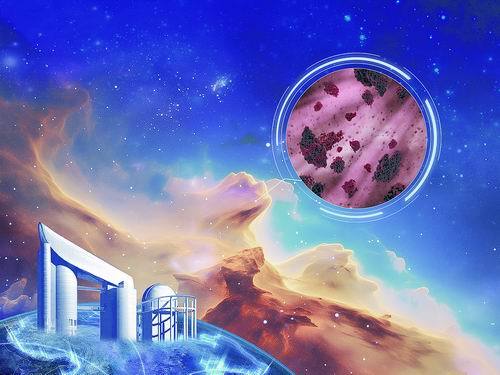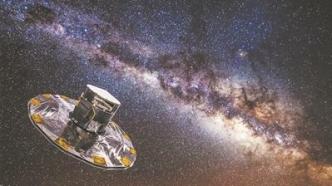
On March 14, Science published a cover article on a scientific research result completed by Zhang Xiangyu, a Chinese doctoral student at the Max Planck Institute in Germany, and his mentor Gregory Green.
Combining data from the Guo Shoujing Telescope (LAMOST) of the National Astronomical Observatory of the Chinese Academy of Sciences with data from the European Space Agency's Gaia satellite, researchers trained the model and built the world's first billion-level star extinction database, and released the first three-dimensional dust extinction characteristic map of the Milky Way covering the entire sky. This study achieved the simultaneous mapping of the three-dimensional dust distribution and extinction curve of the Milky Way, providing an important reference for astronomical observations.
The researchers said that the newly observed extinction distribution characteristics challenge the traditional theory of dust evolution and may suggest some kind of "growth" mechanism for interstellar organic matter.

Schematic diagram of interstellar dust. Image source: OPENVERSE
The Difficulty of Solving the “Extinction” Error
Optical astronomy equipment is an important tool for astronomers to explore the universe. By using optical telescopes and other equipment, astronomers can capture light from distant celestial bodies and obtain various data about these celestial bodies, including their position and motion, temperature and brightness, chemical composition, and structure.
However, the existence of the interstellar medium will affect the accuracy of these data, just like looking at the scenery through a layer of gauze, there is always a deviation between the light information received by people and the actual situation of celestial bodies. The interstellar medium is a general term for matter and energy existing between stars. Most elements heavier than hydrogen and helium exist in the form of small solid particles - dust.
These dust absorbs and scatters starlight, making the stars look dimmer and redder. This phenomenon is called the "extinction effect." Zhang Xiangyu told China Science Daily that it is usually necessary to correct the extinction effect when conducting astronomical observations and obtain the actual situation of the celestial body through reverse calculation.
Different wavelengths of light have different extinction effects, and blue light usually has higher extinction than red light. The characteristic of how extinction changes with the wavelength of light is called the "extinction curve." "The 'extinction curve' is essential for precise astronomical observations, and is also a key observation for studying the physical and chemical properties of dust, such as size and composition, and the interstellar medium environment," said Zhang Xiangyu.
However, for many years, traditional dust research has faced a dilemma. On the one hand, high-precision spectral survey data often cannot cover the entire sky, making it difficult to consider dust in the framework of the evolution of the Milky Way; on the other hand, it is difficult to capture changes in the extinction curve by relying on all-day observations of photometry. This sometimes forces astronomers to conduct research based on the assumption that "the dust extinction curves of the entire Milky Way are the same", which poses a hidden danger of systematic errors in cosmology, exoplanet research, and other studies.
Benefit from the unique advantages of "King of Spectrum"
In order to eliminate the "mines" buried in the above assumptions, the new method of scientists is to obtain a richer data set from the largest possible number of stellar samples to train and verify the model, thereby improving the accuracy and reliability of the model's predictions. In this way, even for stars with poor observation conditions or difficult to measure directly, a relatively accurate extinction curve can be calculated based on the existing model.
In this study, the researchers linked the precise stellar parameters measured by LAMOST, known as the "King of Spectra", with the low-resolution spectral survey data from the Gaia satellite, and ultimately achieved the simultaneous inversion of the extinction curves and stellar parameters of 130 million stars, constructing the first three-dimensional dust extinction characteristic map of the Milky Way covering the entire sky and reaching a depth of about 16,308 light-years.
This milestone achievement was achieved thanks to the unique advantages of LAMOST. Zhang Xiangyu said that LAMOST's large-field multi-target spectral acquisition capability enabled researchers to obtain accurate parameters of a large number of stars in the medium and high extinction regions of the Milky Way disk. At the same time, LAMOST's observational data covers a wide range of star types, allowing the model trained based on LAMOST data to be applied to more than 100 million stars with low-resolution spectra, greatly expanding the breadth and depth of the dust map.
It is understood that this breakthrough achievement has increased the number of currently measured line-of-sight numbers of Milky Way stars by two orders of magnitude, built the world's first "billion-level star extinction database" to date, and realized for the first time the simultaneous mapping of the three-dimensional dust distribution and extinction curve of the Milky Way throughout the day.
Clearing away the fog of interstellar medium
The interstellar medium is an important link in the material cycle in the Milky Way and is also the birthplace of stars such as the sun.
Researchers introduced that the three-dimensional dust stereogram created by the study covers a huge spatial scale, incorporating the physical and chemical properties of dust into the larger framework of the evolution of the Milky Way, revealing the close relationship between the properties of dust and star formation and the structure of the Milky Way. The extinction curve of the star-forming region in the Milky Way is flatter, revealing the process of dust particles growing and aggregating to form larger dust in this region, while the extinction curve in the direction of the center of the Milky Way is steeper, indicating that the special physical and chemical environment that may exist in this region causes the dust particles to be generally smaller.
Traditional theory holds that the closer to the center of the dust cloud, the higher the dust density, and the dust particles will "grow" due to mechanisms such as accretion and aggregation, causing the dust extinction effect to gradually become independent of wavelength and the extinction curve to become flatter and flatter.
Using the three-dimensional dust distribution and extinction curve of the Milky Way, they discovered a completely different phenomenon: near some dust clouds, the higher the dust density, the steeper the extinction curve - blue light is absorbed and scattered more than red light.
"This challenges the cognition based on traditional theories." Zhang Xiangyu believes that this may imply a certain "growth" mechanism of interstellar organic matter - polycyclic aromatic hydrocarbons.
In the view of relevant experts, the newly released three-dimensional dust extinction characteristic map opens a new window for studying dust and the Milky Way. It not only provides an important reference for astronomical observations, but also provides a new perspective for the study of astrochemistry, star formation, galactic carbon cycle, and the origin of life.
Related paper information: http://doi.org/10.1126/science.ado9787
(Original title: "The first three-dimensional dust extinction characteristics map of the Milky Way is released")

